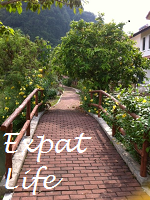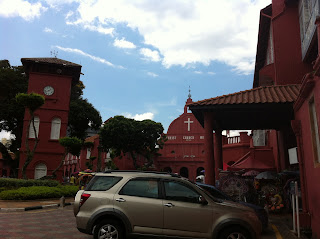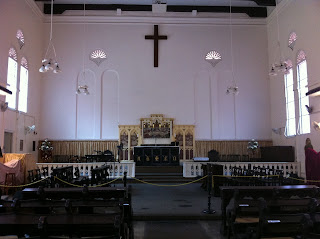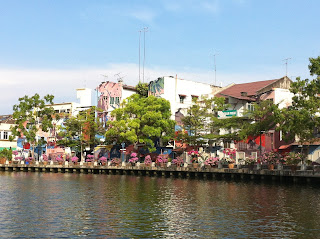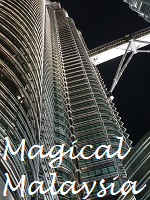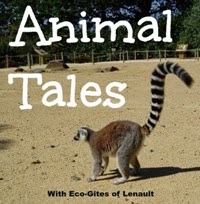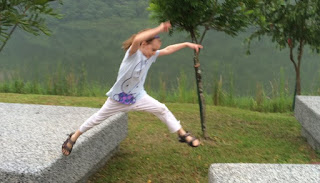I was very honoured
to be nominated to a blogging challenge/award by the lovely Phoebe of LouMessougo. I enjoy reading her blog
immensely and the more I read it the more I think we are related somehow. As a lifelong expat, Phoebe’s life has been
rather similar to mine and I notice from her posts that she thinks along very
similar lines to me.
So the award Phoebe
has kindly nominated me for is the Sisterhood of the World Bloggers award. She has asked me 10 questions which I will
try to answer to the best of my abilities.
In turn I have to nominate another 10 bloggers and ask them 10 questions
of my own and so on.
1. When did you
start blogging? What is your favourite blog post, and why?
I started the blog
in early 2013. I had been thinking about
starting one for a while but had been very busy with work. Starting the blog coincided with a quiet
period for me and helped to keep me busy during a long cold Kazakh winter
during which I had been rather unwell.
I am not sure I can
really pick a favourite post, they all do different things for me at the time I
write them. I loved writing about the memories evoked by flicking through Miss EE’s
passport when it was sent off for renewal.
Expat children get so many wonderful opportunities and grow with each
one. Her passport is like a map of her
life to date. Writing about the time
complete strangers came to help us when our tyre
blew on a dark motorway was humbling – it reminded me how kind people can
truly be and I think I had the most fun with a post called Expat Gadget Hunt about all the weird and
wonderful things I can buy here in Malaysia when I can’t even find something
simple like a knife sharpener.
 |
| The weird and wonderful gadgets you find in host countries |
2. How do you
describe your blog's niche?
Hmm, I’m not sure
that I have a niche as such. As a
perpetual expat I think I am able to look at the challenges and benefits of
expat life from the view of both adults and children and I think I bring an
understanding of the stresses difficult and dangerous postings heap on children
and as an extension of this I write a fair bit about coping with the ups and
downs of expat life. Very few people
blog about life in Kazakhstan and so although we left there a year and a half
ago I still get a lot of people contacting me for advice on a move to the
country or how to sort things out once they are there and while there are a lot
of expats blogging about life in Malaysia very few talk about life in Sarawak
or outside the main cities.
We are about to move
again and I will be reaching out to bloggers in our new host country. There are a few but not that many so it will
be interesting to see how my blog is perceived when I start writing about it.
| Astana is still a niche destination |
3. Do you have a day
job other than blogging? Do you support
yourself blogging?
Sadly my chosen
professions (litigation and politics a heady combination that makes everybody
want to really like me!) are not compatible with expat life. Mr EE was once offered a job by a company who
happened to be looking for someone with pretty much my exact set of
professional skills in the same location and we were offered the two jobs in
tandem. It would have been both
fascinating and exciting. Sadly we had
some ethical objections to the set-up of the schools and had to turn the job
down.
In Astana I was a
regular guest speaker at conferences on encouraging wider participation in
democracy and the growth of local government.
In recent years I have also worked remotely as the relationship manager for
a French company offering holiday rentals, been a school librarian and been the
headmistress of a nursery school. The
latter was a surreal experience as my only background in education is being
married to a teacher but the only qualification they wanted was an expat at a
loose end willing to devote 10 hours a day to the school and who spoke some
Russian. Mr EE has devoted his
professional life to climbing the career ladder to Headmaster. He had just been appointed Headmaster
Designate in Miri when I was approached with the job offer so I beat him to it
by 6 months!
Visa restrictions
have limited my ability to work here in Malaysia, I might get something in KL
but opportunities are pretty much non existent where we are. I don’t like doing nothing, however, so I
have taken on some freelance writing jobs through an online freelancing
portal. They keep me sane and help me
maintain my mental edge. Mini EE will be
old enough to go to the crèche in the next posting and once we are settled I
might look into some possible opportunities in the local area.
| Politics - not an expat friendly career (but I don't miss canvassing) |
4. Do you do other
writing or photography professionally?
The freelance
writing has really taken off. When I
started in January this year I had only the one client but as my portfolio has
grown I have gained a lot of repeat custom and I am probably at capacity for
the moment. I don’t really have the time
to do as much as I would like – school runs and the baby eat into the day and
if I can’t find something in our new posting I will concentrate on the writing
and try to grow my client base.
I am a keen
photographer but not a good one. I have
read the theory and understand the mechanics of photography but I do not have a
natural eye and I keep forgetting to check simple things (one time a whole set
of photos were ruined because Mini EE had fiddled with the camera while I was
not looking and changed the ISO settings).
Mr EE, by contrast, knows nothing of the theory but gets a beautifully
framed shot every time. Between us we
would probably do a good job!
| A mediocre (but always hopeful) photographer |
5. What is your most
popular post? Why do you think it's so
popular?
The most visited
post is one I wrote early on about how to bake without self-raising flour. It talks about how to make your own baking powder
and what to use if you can’t find any.
It is a very practical post.
Reading it back now I would probably write it very differently and it is
on my list to review in the future.
The post people have
engaged with the most is a photo tour of Astana.
Astana is one of those expat
destinations that is still very ‘out there’.
With little information available for future expats the page seems to be
a popular portal for those wanting to find out a little more about what they
can expect in Astana.
 |
| How to make baking powder! |
6. What's your
biggest challenge or frustration as a blogger?
I would love to have
more time to write. I am also not hugely
fond of the blogger format that I use. I
wanted to create a wordpress blog but access was restricted in Kazakhstan at the time and
we did not have a VPN. Rather annoyingly
the restriction was removed some months later but by then I was already tied in
to blogger.
| Time goes too fast |
7. Name some of your
favourite blogs. Why? What makes a great blog in your opinion?
I love Diplomatic
Dog by Scruffy Nellie. She is Britain’s
Canine representative in Guyana but I knew her when she was rescued off the
streets in Kazakhstan and she is a good friend to our two dogs. Her blog is an excellent way to see how she
is getting on and her owner takes excellent photographs to boot. She runs her own (non-canine) site called
Less Blather More Bite which is always worth a look.
The DawlishChronicles by Antoine Vanner. He writes
about many lesser known stories of adventure and derring-do in the latter part
of the 19th century. His
blogs are always worth a read.
I often pop by the
hugely informative Your Expat Child run
by Carole Hallett Mobbs– there is always something of interest on there and she
is lovely to write to as well. The Dumpling Cart run
by Celia is an eclectic mix of stories from around the world, often told through
some very innovative data analysis. The Cujo Cat Chronicles always make me laugh out loud and bring a bit of light relief on
hectic days.
I also read a lot of
political blogs but there are too many to mention here as the list could go on
forever – of course I love reading all
the blogs by the ‘sisters’ I am going to nominate and Phoebe’s Lou Messugo blog
as well.
8. What is your best
travel memory? Why?
When I was studying
for my A Levels we were living in Eastern Turkey. The security situation, which is never really
good there, was dire at the time and we were very restricted in where we could
go. We had to take 4 bodyguards with us
wherever we went and, on some cases, even more.
Security would have been made available for us to go to even the most inaccessible places if we asked
but it was a privilege we did not want to abuse too often.
As such we did not
get to see as much of the local area as we would have liked and some trips to
Mardin and Lake Hazar aside we spent most of the time on the camp in Diyarbakir. One weekend, however, we were able to arrange
a driving tour to see Nemrut Dag. This
megalomaniacal mausoleum consists of a gravel pyramid on the summit of Mount
Nemrut surrounded by terraces of a pantheon of Gods, the heads of which stand
higher than a man. Driving to the hotel
we went past bridges built by Septimus Severus and an old castle discovered by
the older von Moltke during his time in Turkey just crying out for more detailed excavation but
having to wait its turn. The following
day we went to visit the Attaturk Dam which was, still under construction and
were given a guided tour of the whole project.
I have been lucky
enough to go to some amazing places and see some truly wonderful things but
this weekend was special. I am not quite
sure why – perhaps because it was so unusual in our (necessarily) cloistered
life at the time or perhaps because we were the only people sightseeing in the
area that weekend but I felt very privileged to be there.
| Turkey holds some of my best travel memories |
Only 3? I really want to go to Vietnam and Laos. We were hoping to take our car up from Ipoh
and drive across from Thailand over this last summer but the timings just did
not work out. Namibia is very high on my
list – the animals, the scenery, it looks like a holiday dream
destination. Finally Mr EE and I have
wanted to take an Antarctic cruise since around the time we met, Ideally out of
New Zealand for the chance to see some of ‘historic’ Antarctica and I would also like to do some diving while we
are there. The costs are prohibitive for
us at the moment – it is expensive enough for 2 let alone 5 and Mini EE is far
too young to get anything out of it so it is on the back burner for the
moment.
10. Is food important to you when you travel
(other than its obvious function as fuel!)? What is the weirdest food you've
ever eaten?
I am not adventurous
in the food stakes by which I mean I enjoy a wide variety of world cuisines but
am not excited by the opportunity to enjoy weird food. Mr and Master EE will eat just about anything
(although they are not keen on chicken).
When I eat something I enjoy I try to collect recipes to try to
replicate the dish at home.
As for the weirdest
thing – I have been offered but managed to avoid eating Monkey (there would
have to be a pretty dire threat to make that dish appetising) and I have bought and cooked a joint of something whose label translated as ‘swine cervix’. I chose to hope that it was a neck cut rather
than an actual cervix and I comfort myself that it did not look cervical in
nature. Horse was common in Kazakhstan
and although not a meat I choose to eat I can and will if I have to to be
polite. I have eaten marmite once and
once ever (I mistook it for chocolate spread on my first morning in boarding
school – the mistress made me eat the whole slice of toast). In Ireland white and black (blood) pudding are
popular for breakfast, I ate it once ever at Granny’s house and was so upset
that she never made me eat it again. I
have tried haggis and wish it had never crossed my lips!
I find milk deeply
unpleasant and some of the weirdest things I have had to drink involve it. Milky tea in Britain (why would an adult put
milk in tea?), I have since realised that you have to specify your tea (or what
the British pass off as tea) black if you are not to be greeted with a mug of
some hot milky vomit inducing liquid in some British homes. Funnily enough British friends and family who
ask for milk in their tea are absolutely revolted by the stuff I give them even when it is made with their
tea bags as I never seem to get the ratios of milk to tea right. I now routinely ask people to make their own. Ayran or fermented
mare’s milk was popular in Turkey and Kazakhstan and was often given as a
welcome drink; drinking it was always a trial.
I thought that was about as bad as milk got but it gets worse – Shubat or
fermented camel’s milk popular amongst Kazakhs is truly vile. In fact writing this has made me think of the idea of British tea made with Shubat which must be about as grim as it gets!
 |
| Enjoy your swine cervix and other random foods... |
So having got that
part out of the way I get to do the fun part and nominate my chosen ‘sisters’, in no particular order they are.
- Life With A Double Buggy (I love reading this Blog as it is the exact reverse of my experience of moving from the Netherlands to UK)
- Bringing Up Brits (this resonates with my experiences of raising our children in the UK)
- Chicken Ruby (a wonderfully eclectic blog with such beautiful photographs)
- Tiny Expats (on point observations on life with expat children in some fascinating destinations)
- Olive Feta & Ouzo (some really insightful posts on expat life)
- The Dumpling Cart (a fresh viewpoint on a wide range of issues)
- Scruffy Nellie (who would not want to learn more about this cute woof)
- Seychelles Mama (mum to two beautiful little boys living a real life in other people’s paradise destination)
- Your Expat Child (a goldmine of information)
- MumturnedMom (who always seems to manage her expat life with such grace)
So without further
ado the questions I want to posit are:
- What was your first expat posting?
- What was your most memorable posting?
- What is your advice for settling into a new posting?
- What are the biggest frustrations in your current posting?
- What are the best points of your current posting?
- How do you come to terms with saying goodbye when it is time to move on?
- Where would you like to move to next?
- What is the thing that you miss the most from your home country?
- Why did you decide to start blogging?
- Please tell us a little about your most embarrassing expat/cultural mishap.
Click on the picture for more posts on Expat Life

